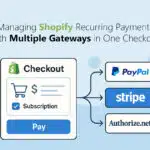
Embracing Recurring Charges: A Guide for E-commerce Businesses
As e-commerce businesses grow, offering subscriptions is a trend gaining significant traction in the post-pandemic business landscape. The subscription model leverages the power of recurring charges to convert irregular revenue from repeated one-off sales, into the much more lucrative, recurring revenue from subscriptions.
Implementing recurring charges has resulted in improved revenue growth and enhanced customer loyalty for countless businesses of all sizes. However, as business owners, it’s natural to have concerns about transitioning to a subscription-based approach that actually profits your business.
In this blog post, we’ll explore how e-commerce businesses can successfully expand into subscriptions, address common concerns, and reap the rewards of this increasingly popular business approach.
Let’s start with what is recurring charges model, and why it’s worth considering.
Why Consider Recurring Charges?
Before diving into the concerns, let’s highlight why transitioning to a subscription model is worth considering:
- Steady Revenue: Subscriptions offer a predictable stream of income, which can help stabilize your business’s financial health and also greatly facilitate revenue forecasting.
- Loyal Customer Base: Subscribers tend to stick around longer and engage more with your brand, leading to stronger customer relationships. Enhanced customer loyalty is highly lucrative through word-of-mouth marketing as well.
- Market Expansion: The subscription model can attract new customers who are looking for convenient and personalized experiences.
Some Common Concerns & Their Resolution
Now, let’s tackle some common concerns e-commerce business owners may have when thinking about introducing recurring charges in their online store.
1. Transitioning from One-Time Sales
Concern: Moving away from one-time sales may seem risky. Will we lose revenue?
Solution: You don’t have to abandon one-time sales entirely. In fact, it is recommended not to do so. Implementing both one-time and recurring charges is the best strategy to maximize eCommerce revenue. Many businesses successfully combine subscriptions with traditional sales, offering both options to customers.
Read More: Recurring vs Reoccurring Revenue: Understanding the Key Differences
2. Customer Acquisition Costs
Concern: How much will it cost to acquire and retain subscribers?
Solution: While acquiring subscribers may have upfront costs, the long-term benefits often outweigh them. This is because a subscriber who is effectively engaged and utilizing a valuable subscription offering will have a much higher customer lifetime value for your business. Account expansion through upgrade, downgrades, as well as cross selling and offering bundles, will keep growing revenue within the same customer count.
3. Inventory Management
Concern: Subscriptions may require more inventory planning and management. What if we run out of stock or have excess inventory?
Solution: Implementing inventory forecasting and management systems to ensure you have the right amount of stock will fix this issue. Data-driven insights can help optimize inventory levels. SubscriptionFlow, subscription management platform can post-back orders to track inventory and seamlessly integrates with ecommerce stores on Shopify, WordPress, WooCommerce etc. streamlining inventory management.
4. Subscription Churn
Concern: What if customers cancel their subscriptions too frequently?
Solution: Churn is a reality in subscription businesses. Focus on providing and growing value, personalized experiences, and addressing customer concerns to reduce churn rates. Although some amount of churn is inevitable, there are many proven strategies to suppress subscriber churn.
Read More: Effectively Deflect Churn: Demystifying Churn Indicators
How to Prepare for a Successful Transition?
Before making the leap into subscriptions, there are steps you can take to ensure a smooth transition.
1. Market Research
Understand your target audience and their subscription preferences. Conduct surveys or analyze data to identify what products or services they’d be willing to subscribe to. Use this to identify opportunities in your industry.
2. Pricing Strategy
Determine your pricing structure carefully. Consider offering tiered subscription plans to cater to different customer segments and price points.
Read More: How Tiered Pricing Strategy Can Help You Retain B2B Customers
3. Add Value
Ensure that your subscription offering provides real value to subscribers. Exclusive content, early access, discounts, or unique products can all be enticing.
4. Tech Stack
Invest in subscription management tools and plugins that streamline subscription billing, manage subscribers and offer robust reporting & analytics. Automation can save you time and resources as well as ensure accurate billing & invoicing, maximum renewals and deep insights into opportunities for growth.
5. Marketing and Communication
Plan your subscription launch carefully. Create compelling marketing campaigns and communicate the benefits of subscribing clearly to your customers.
How to Mitigate Risks Associated with Recurring Charges?
While subscriptions offer numerous benefits, it’s essential to mitigate potential risks.
1. Analytics and Data
Regularly analyze subscriber data to identify trends, preferences, and potential issues. Data-driven insights can help you make informed decisions.
2. Customer Feedback
Actively seek feedback from subscribers and non-subscribers alike. Use this feedback to continuously improve your subscription offering. Exit surveys are a great way to understand why your target audience was unconvinced to pay you recurrently.
3. Scalability
Ensure your business can scale its subscription offering as it grows. Be prepared to adjust resources and infrastructure to accommodate increased demand.
How to Measure Success?
Track key performance indicators (KPIs) to assess the success of your implementation. Common KPIs include customer acquisition cost (CAC), customer lifetime value (CLV), churn rate, and revenue growth.
Read More: Metrics that Matter: A Deep Dive into MRR, ARR, Churn, and ARPU for Subscription Business Models
Final Remarks
Expanding into subscriptions can be a rewarding journey for e-commerce businesses. While concerns are natural, with the right strategies, preparations, and a customer-centric approach, you can unlock the potential of recurring revenue and customer loyalty.
Embrace the subscription model as a valuable addition to your e-commerce strategy, and watch your business thrive in the ever-evolving digital marketplace. Remember, the transition may have its challenges, but the rewards are well worth the effort.










